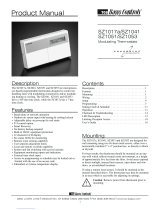
PKG-SVP01B-EN 7
General
InformationProgramming
UCM Control System
The IntelliPak
®
self-contained unit is
controlled by a microelectronic control
system that consists of a network of
modules. These modules are referred to
as unit control modules (UCM). In this
manual, the acronym UCM refers to the
entire control system network.
The unit size, type, heating functions,
peripheral devices, options, exhaust
capabilities, etc. determine the number
and type of modules that a particular unit
may have.
These modules perform specific unit
functions using proportional/integral
control algorithms. They are mounted in
the unit control panel and are factory
wired to their respective internal compo-
nents. By processing analog and binary
inputs, each module supplies outputs in
the form of modulating voltages (from
other unit modules, sensors, remote
panels, and customer binary contacts) to
perform the applicable request; such as
economizing, mechanical cooling,
heating, ventilation.
The UCM provides some equipment
protection functions both directly and
indirectly, such as duct pressure limits
and compressor lockouts.
Following is a description of each
module’s function within the UCM
system.
RTM Module Board - Standard on all
Units
The RTM is the central processor of the
system. It continuously receives informa-
tion from the other unit modules, sensors,
the remote control panel, and customer
supplied relays. It interprets this informa-
tion and responds to cooling, heating, and
ventilation requests by directing the other
modules in the system to energize the
proper unit components. It also directly
initiates supply fan operations, and
economizer operation.
Compressor Modules (SCM and MCM )
The compressor modules (single circuit
and multiple circuit) energize the appro-
priate compressors and condenser fans
upon receiving a request for mechanical
cooling. The modules monitor the
compressor operation through feedback
from various protection devices.
Heat Module - Standard on all Heating
Units
The heat module directs the unit’s heater
to stage up and down to bring the zone
temperature within the applicable
heating setpoint.
Exhaust/Comparative Enthalpy Module
(ECEM) Option
The ECEM is on units with the compara-
tive enthalpy option. It receives data from
the return air humidity sensor, the return
air temperature sensor, and the return air
space pressure transducer and controls
dampers to maintain space pressure and
humidity levels.
Generic Building Automation System
(GBAS) Module Option
The GBAS module links the RTM with
non-Trane building control systems to
enable communication (input/output
interface) between the systems. It can
accept external setpoints for cooling,
heating, demand limiting, and S/A
pressure.
Ventilation Override Module (VOM)
Option
The VOM can control the unit’s air
handling functions to perform customer-
specified functions, such as space
pressurization, exhaust, purge, unit off,
etc.
Interprocessor Communications Board
(IPCB) Option
The IPCB is used to expand communica-
tion from the unit’s UCM network to a
remote human interface panel. DIP
switch settings on the IPCB module for
this application should be; switches 1 and
2 “off,” switch 3 “on.”
Trane Communications Interface Module
(TCI) Option
The TCI module allows external setpoints
for most of the unit functions to be
communicated to the unit’s UCM network
via a Trane ICS
TM
system. DIP switch
settings on the TCI module for these
applications should be; switches 1, 2, and
3 are “off.”
Human Interface Module (HI)
The HI module illustrated in Figure P-GI-1,
on page 9, enables the user to communi-
cate unit operating parameters; such as
cooling and heating setpoints, demand
limiting, ventilation override modes, etc.
The HI module is in the unit’s main control
panel. A small door located in the unit’s
control panel door allows access to the HI
module keypad and display window.
The HI has a 2 line by 40 character LCD
screen to provide status information for
various unit functions and menus to set or
modify operating parameters. There is a
16-key keypad adjacent to the LCD
screen to allow the user to scroll through
the various menus and make adjust-
ments to setpoints, etc.
The information displayed in the LCD
window is top-level status information
unless the operator initiates other
displays.
At power-up, the human interface LCD
displays one of four initial screens as
illustrated in the “General Status
Display”section on page 11 and de-
scribed below:
1. Unit Off (unit off or stopped)
The unit is configured and operational,
but is not running. This screen shows
state, mode, and function information
when the unit is off or stopped.
2. Unit On (unit on)
The unit is configured and operational,
and is running. This screen shows state,
mode, and function information when
the unit is on.
3. VOM Active (a ventilation override
command was received)
This screen shows that the unit is in a
ventilation override mode.
4. No Configuration (the unit needs to be
configured)
This screen shows that required
configuration data is missing.
The LCD screen display will go out if no
keys are pressed for 30 minutes. If it goes
out, simply press the STATUS key.





















